Runoff Volume Reduction Using Green Infrastructure
Abstract
:1. Introduction
- locating rain gardens within the borders of a given property—large amount of dispersed LID solutions;
- centralized location in public areas [22].
2. Materials and Methods
- local urban floods and flooding occur even in the case of low intensity rainfalls;
- due to the soil conditions, LID based on infiltration cannot be applied in the entire area of the catchment;
- the existing form of development and management of the area allow for the implementation of simple rainwater collection systems [12];
- the location of LID structures is possible mainly in the area of private land plots.
- Calculation nodes—190 nodes and 2 outlets;
- Calculation segments—189 segments of canals;
- Stormwater catchments—140 catchments;
- Series of data—such as rainfall data, modelled and historical—registered at the IMGW meteorological station.
- V1—current state—as a variant of the lack of assumed modernization decisions—described by the calibrated simulation model;
- V2—modernization based on classical methods—mainly retention;
- V3—retention and infiltration in rain gardens;
- V4—retention and infiltration in rain gardens and infiltration trench;
- V5—retention and infiltration in rain gardens and infiltration trench connected with unsealing garage driveways and parking places near multi-family buildings.
- reinforced concrete, underground retention chamber with an active capacity of 320 m3;
- an underground reinforced concrete tank with an active capacity of 460 m3, including a tank with a capacity of 100 m3 for pre-treated sewage with an uptake point for water for municipal purposes;
- modernization of existing open retention tank, with an active capacity of 3640 m3, including 100 m3 of the tank for pre-treated sewage with an uptake point for water for municipal purposes;
- constructing a by-pass eliminating the influence of too densely located wells in Szarych Szeregów Street;
- reconstruction of conduits situated with a negative slope.
- hmax—maximum rainfall depth, mm;
- t—duration of rainfalls, min.;
- p—probability of exceeding rainfalls: p ∈ (0,0.5];
- α—parameter dependent on the region of Poland and duration time t.
- Berm Height—100 mm;
- Vegetation Volume Fraction—0.1;
- Surface Rougness—0.013;
- Surface Slope—1%;
- Soil Thickness—1000 mm;
- Porosity (volume fraction)—0.33;
- Field Capacity (volume fraction)—0.25;
- Wilting Point (volume fraction)—0.15;
- Conductivity—100 mm/h;
- Conductivity Slope—1;
- Suction Head—5 mm.
- infiltration trenches along the street on the northern border of the analysed subcatchment;
- unsealing garage driveways in single-family, semi-detached and terraced houses;
3. Results
- the calculations were carried out for a full day;
- a simulation of a preliminary day was introduced with the assumption of rain-free weather, due to the entirely separate nature of the stormwater network;
- the calculations were carried out under the assumption of a calculation step equal to 1 second and reporting every 15 seconds.
4. Discussion
- the introduction of LID solutions, such as rain barrels, rain gardens or different forms of infiltration, is possible at the planning, design and realization stage;
- it is possible to correlate design activities in the scope of planned and realized works in common areas (municipal, common areas of communes, etc.) and at the border of properties and urban areas—for example, unsealed driveways from the roadway to the garage gate.
5. Conclusions
- reducing the flow rate and depth (surcharge) in the stormwater network facilitates is conducive to reducing the scale of local flooding, especially during low intensity rainfalls events;
- the application of LID in connection with classical methods allowing for stormwater runoff to be delayed has a significant influence on protecting the receiver; among others, by decreasing the flow intensity in canals, it facilitates the reduction of the leaching of contaminants found the stormwater network and reduces the hydraulic and quality load on the receiver;
- runoff in the case of a dispersed manner of applying LID fulfils the condition of partially returning the natural water cycle in the catchment; this is done directly when dealing with rain gardens and other solutions based on infiltration;
- the application of LID may be treated as a universal solution allowing for urban floods or the local flooding of the area or buildings to be prevented only in the case of a stormwater system designed and constructed under assumptions accounting for climate changes and rigorous maintenance of a constant level of imperviousness in the urban catchment area;
- an optimal solution is applying LID elements in a dispersed manner, realized alongside classical solutions, such as retention in tanks, retention in conduits, or introducing elements which direct the flow of stormwater. This is confirmed by the results obtained by Damodaram et al. [14], Liu et al. [20], Xie et al. [49] and Alves et al. [50]. Designing such a "hybrid" system must be preceded by a detailed analysis of the terrain, geological and hydrological possibilities and ensuring appropriate hydraulic conditions for the flow in canals and network facilities (maintaining optimum flow velocity and avoiding surcharging of elements of the drainage system);
- the analysed solutions, whether this be rain gardens or combinations of several solutions, are largely similar from a hydraulic point of view and it is thus, possible to adapt the selection of individual choices based on the individual preferences of the inhabitant, or even applying both solutions concurrently;
- LID solutions ought to be, whenever possible, looked into at the stage of planning the development of the land infrastructure; in areas that are already built-up, the possibilities for their realization drop drastically. Investors and land plot owners will, for the most part, not change their attitude unless financial encouragement programs are implemented.
- introducing of national and local limitations connected with the drainage of stormwater into the stormwater sewer network [58];
- raising social awareness on making use of rainwater on private properties and in common residential areas [59], supported by implementing a program of financial initiatives as economic supplementation and support for investment at the border of the property and municipal area.
Funding
Data Availability Statement
Conflicts of Interest
References
- Suchocka, M.; Siedlecka, M. Vegetation as an important element of precipitation water management on urban areas (Roślinność jako ważny element systemu gospodarowania wodami opadowymi na terenach miejskich). Drogownictwo 2017, 7–8, 236–243. [Google Scholar]
- Palla, A.; Gnecco, I. Hydrologic modeling of Low Impact Development systems at the urban catchment scale. J. Hydrol. 2015, 528, 361–368. [Google Scholar] [CrossRef]
- Eckart, K.; McPhee, Z.; Bolisetti, T. Multiobjective optimization of low impact development stormwater controls. J. Hydrol. 2018, 562, 564–576. [Google Scholar] [CrossRef]
- Berndtsson, R.; Becker, P.; Persson, A.; Aspegren, H.; Haghighatafshar, S.; Jönsson, K.; Larsson, R.; Mobini, S.; Mottaghi, M.; Nilsson, J.; et al. Drivers of changing urban flood risk: A framework for action. J. Environ. Manag. 2019, 240, 47–56. [Google Scholar] [CrossRef] [PubMed]
- Eckart, K.; McPhee, Z.; Bolisetti, T. Performance and implementation of low impact development A review. Sci. Environ. 2017, 607–608, 413–432. [Google Scholar] [CrossRef]
- Fletcher, T.D.; Shuster, W.; Hunt, W.F.; Ashley, R.; Butler, D.; Arthur, S.; Trowsdale, S.; Barraud, S.; Semadeni-Davies, A.; Bertrand-Krajewski, J.L.; et al. SUDS, LID, BMPs, WSUD and more The evolution and application of terminology surrounding urban drainage. Urban Water J. 2015, 12, 525–542. [Google Scholar] [CrossRef]
- Tahvonen, O.; Airaksinen, M. Low-density housing in sustainable urban planning Scaling down to private gardens by using the green infrastructure concept. Land Use Policy 2018, 75, 478–485. [Google Scholar] [CrossRef]
- Coffman, L. Low-Impact Development Design Strategies; An Integrated Design Approach (Report). EPA 841-B-00-003; Department of Environmental Resources, Programs and Planning Division: Prince George’s County, MD, USA, 2000; pp. 25–45.
- Woods-Ballard, B.; Wilson, S.; Udale-Clarke, H.; Illman, S.; Scott, T.; Ashley, R.; Kellagher, R. The SuDS Manual; CIRIA: London, UK, 2015; pp. 19–30. [Google Scholar]
- Zhong, R.; Xu, M.; Vieira Netto, R.; Wille, K. Influence of pore tortuosity on hydraulic conductivity of pervious concrete: Characterization and modeling. Constr. Build. Mater. 2016, 125, 1158–1168. [Google Scholar] [CrossRef]
- Suripin, S.; Sangkawati, S.S.; Pranoto, S.A.; Sutarto, E.; Hary, B.; Dwi, K. Reducing Stormwater Runoff from Parking Lot with Permeable Pavement. E3S Web Conf. 2018, 73, 05016. [Google Scholar] [CrossRef] [Green Version]
- Mao, X.; Jia, H.; Yu, S.L. Assessing the ecological benefits of aggregate LID-BMPs through modelling. Ecol. Model. 2017, 353, 139–149. [Google Scholar] [CrossRef]
- Li, Q.; Wang, F.; Yu, Y.; Huang, Z.; Li, M.; Guan, Y. Comprehensive performance evaluation of LID practices for the sponge city construction: A case study in Guangxi, China. J. Environ. Manag. 2019, 231, 10–20. [Google Scholar] [CrossRef]
- Damodaram, C.; Giacomoni, M.H.; Khedun, C.P.; Holmes, H.; Ryan, A.; Saour, Q.; Zechman, E.M. Simulation of combined best management practices and low impact development for sustainable stormwater management. J. Am. Water Resour. Assoc. 2010, 46, 907–918. [Google Scholar] [CrossRef]
- Zimmer, C.A.; Heathcote, I.W.; Whiteley, H.R.; Schroeter, H. Low Impact Development Practices for Stormwater Implications for Urban Hydrology. Can. Water Resour. J. 2007, 32, 193–212. [Google Scholar] [CrossRef]
- Jia, H.; Lu, Y.; Yu, S.L.; Chen, Y. Planning of LID–BMPs for urban runoff control: The case of Beijing Olympic Village. Sep. Purif. Technol. 2012, 84, 112–119. [Google Scholar] [CrossRef]
- Bąk, J. Modelling the relationship between LID practices and the runoff of rainwater through the example of rainfall data for Krakow. E3s Web Conf. 2018, 45. [Google Scholar] [CrossRef] [Green Version]
- Mrowiec, M.; Sobczyk, M. Ecological management of rainwaters green roofs. Water-Environ. Rural Areas 2014, 48, 53–61. [Google Scholar]
- Olorunkiya, J.; Fassman, E.; Wilkinson, S. Risk: A Fundamental Barrier to the Implementation of Low Impact Design Infrastructure for Urban Stormwater Control. J. Sustain. Dev. 2012, 5, 27–41. [Google Scholar] [CrossRef]
- Liu, Y.; Bralts, V.F.; Engel, B.A. Evaluating the effectiveness of management practices on hydrology and water quality at watershed scale with a rainfall-runoff model. Sci. Total Environ. 2015, 511, 298–308. [Google Scholar] [CrossRef] [PubMed]
- Huang, C.L.; Hsu, N.S.; Liu, H.J.; Huang, Y.H. Optimization of low impact development layout designs for megacity flood mitigation. J. Hydrol. 2018, 564, 542–558. [Google Scholar] [CrossRef]
- Basdeki, A.; Katsifarakis, L.; Katsifarakis, K.L. Rain Gardens as Integral Parts of Urban Sewage Systems-a Case Study in Thessaloniki, Greece. Procedia Eng. 2016, 162, 426–432. [Google Scholar] [CrossRef] [Green Version]
- Strecker, E.; Huber, W.; Heaney, J.; Bodine, D.; Sansalone, J.; Quigley, M.; Leisenring, M.; Pankani, D.; Thayumanavan, A. Critical Assessment of Stormwater Treatment and Control Selection Issues. Final Report to the Water Environment Research Foundation, WERF 02-SW-1. 2005. Available online: http://documents.irevues.inist.fr/bitstream/handle/2042/25192/0263_269strecker.pdf?sequence=1(accessed on 16 March 2019).
- RainGardens.info. Available online: https://raingardens.info/ (accessed on 15 May 2020).
- Raingardens. Melbourne Waters. Available online: https://www.melbournewater.com.au/media/452/download (accessed on 15 May 2020).
- Ogrody Deszczowe w Gruncie. Instrukcja Budowy (in Polish). Sendzimir Foundation. Available online: https://sendzimir.org.pl/publikacje/broszury-instruktazowe-dot-zwiekszania-retencji-krajobrazowej/ (accessed on 28 December 2020).
- Zhu, Z.; Chen, X. Evaluating the Effects of Low Impact Development Practices on Urban Flooding under Different Rainfall Intensities. Water 2017, 9, 548. [Google Scholar] [CrossRef]
- Kong, F.; Ban, Y.; Yin, H.; James, P.; Dronova, I. Modeling stormwater management at the city district level in response to changes in land use and low impact development. Environ. Model. Softw. 2017, 95, 132–142. [Google Scholar] [CrossRef]
- Bosley, E.K., II. Hydrologic Evaluation of Low Impact Development Using a Continuous, Spatially-distributed Model. Master’s Thesis, Virginia Polytechnic Institute and State University, Blacksburg, VA, USA, 2008. Available online: https://www.researchgate.net/publication/265824795_Hydrologic_Evaluation_of_Low_Impact_Development_Using_a_Continuous_Spatially-Distributed_Model_in_Memoriam (accessed on 16 March 2019).
- Granata, F.; Gargano, R.; de Marinis, G. Support Vector Regression for Rainfall-Runoff Modeling in Urban Drainage: A Comparison with the EPA’s Storm Water Management Model. Water 2016, 8, 69. [Google Scholar] [CrossRef]
- Nowogoński, I.; Ogiołda, E. Verification of the combined sewage system simulation model based on the example of the city of Głogów. E3s Web Conf. 2018, 45. [Google Scholar] [CrossRef] [Green Version]
- Rossman, L.A. Modeling Low Impact Development Alternatives with SWMM. J. Water Manag. Modeling 2010, 18, 167–182. [Google Scholar] [CrossRef] [Green Version]
- Zhu, Z.; Chen, Z.; Chen, X.; Yu, G. An assessment of the hydrologic effectiveness of low impact development (LID) practices for managing runoff with different objectives. J. Environ. Manag. 2019, 231, 504–514. [Google Scholar] [CrossRef]
- Brunetti, G.; Šimůnek, J.; Turco, M.; Piro, P. On the use of surrogate-based modeling for the numerical analysis of Low Impact Development techniques. J. Hydrol. 2017, 548, 263–277. [Google Scholar] [CrossRef] [Green Version]
- Brunetti, G.; Šimůnek, J.; Bogena, H.; Baatz, R.; Huisman, J.A.; Dahlke, H.; Vereecken, H. On the information content of cosmic-ray neutron data in the inverse estimation of soil hydraulic properties. Vadose Zone J. 2019, 18. [Google Scholar] [CrossRef] [Green Version]
- Turco, M.; Brunetti, G.; Carbone, M.; Piro, P. Modelling the hydraulic behaviour of permeable pavements through a reservoir element model. In Proceedings of the International Multidisciplinary Scientific GeoConference Surveying Geology and Mining Ecology Management, Sofia, Bulgaria, 2–8 July 2018; pp. 507–514. [Google Scholar] [CrossRef]
- Nowogoński, I.; Ogiołda, E. Modelling technique of interaction between pressure and gravity sewage systems. E3s Web Conf. 2018, 44. [Google Scholar] [CrossRef] [Green Version]
- Rossman, L.A. Storm Water Management Model User’s Manual Version 5.1, [EPA/600/R-14/413b; US EPA National Risk Management Research Laboratory: Cincinnati, OH, USA, 2015; pp. 46–79.
- Krebs, G.; Kokkonen, T.; Valtanen, M.; Setälä, H.; Koivusalo, H. Spatial resolution considerations for urban hydrological modelling. J. Hydrol. 2014, 512, 482–497. [Google Scholar] [CrossRef]
- Nowogoński, I. Low impact development modeling to manage urban stormwater runoff: Case study of Gorzów Wielkopolski. J. Environ. Eng. Landsc. Manag. 2020, 28, 105–115. [Google Scholar] [CrossRef]
- Bogdanowicz, E.; Stachý, J. Maximum rainfall in Poland—a design approach. In The Extremes of the Extremes: Extraordinary Floods; Snorasson, A., Finnsdottir, H.P., Moss, M., Eds.; IAHS Publication: Reykjavik, Iceland, 2002; Volume 171, pp. 15–18. [Google Scholar]
- Zhang, L.; Oyake, Y.; Morimoto, Y.; Niwa, H.; Shibata, S. Flood mitigation function of rain gardens for management of urban storm runoff in Japan. Landsc. Ecol. Eng. 2020, 16, 223–232. [Google Scholar] [CrossRef]
- Jia, Z.; Tang, S.; Luo, W.; Li, S.; Zhou, M. Small scale green infrastructure design to meet different urban hydrological criteria. J. Environ. Manag. 2016, 171, 92–100. [Google Scholar] [CrossRef]
- Li, H.; Sharkey, L.J.; Hunt, W.F.; Davis, A.P. Mitigation of impervious surface hydrology using bio-retention in North Carolina and Maryland. J. Hydrol. Eng. 2009, 14, 407–415. [Google Scholar] [CrossRef] [Green Version]
- Shafique, M.; Kim, R.; Kyung-Ho, K. Green Roof for Stormwater Management in a Highly Urbanized Area: The Case of Seoul, Korea. Sustainability 2018, 10, 584. [Google Scholar] [CrossRef] [Green Version]
- Ahiableme, L.M.; Engel, B.A.; Chaubey, I. Effectiveness of low impact development practices in two urbanized watersheds: Retrofitting with rain barrel/cistern and porous pavement. J. Environ. Manag. 2013, 119, 151–161. [Google Scholar] [CrossRef] [PubMed]
- Zhang, L.; Ye, Z.; Shibata, S. Assessment of rain garden effects for the management of urban storm runoff in Japan. Sustainability 2020, 12, 9982. [Google Scholar] [CrossRef]
- Seo, M.; Jaber, F.; Srinivasan, R.; Jeong, J. Evaluating the Impact of Low Impact Development (LID) Practices on Water Quantity and Quality under Different Development Designs Using SWAT. Water 2017, 9, 193. [Google Scholar] [CrossRef]
- Xie, J.; Chen, H.; Liao, Z.; Gu, X.; Zhu, D.; Zhang, J. An integrated assessment of urban flooding mitigation strategies for robust decision making. Environ. Model. Softw. 2017, 95, 143–155. [Google Scholar] [CrossRef]
- Alves, A.; Gersonius, B.; Sanchez, A.; Vojinovic, Z.; Kapelan, K. Multi-criteria Approach for Selection of Green and Grey Infrastructure to Reduce Flood Risk and Increase CO-benefits. Water Resour. Manag. 2018, 32, 2505–2522. [Google Scholar] [CrossRef]
- La Rosa, D.; Pappalardo, V. Planning for spatial equity A performance based approach for sustainable urban drainage systems. Sustain. Cities Soc. 2019. [Google Scholar] [CrossRef]
- Anim, D.O.; Fletcher, T.D.; Pasternack, G.B.; Vietz, G.J.; Duncan, H.P.; Burns, M.J. Can catchment-scale urban stormwater management measures benefit the stream hydraulic environment? J. Environ. Manag. 2019, 233, 1–11. [Google Scholar] [CrossRef] [PubMed]
- Srishantha, U.; Rathnayake, U. Sustainable urban drainage systems (SUDS) what it is and where do we stand today? Eng. Appl. Sci. Res. 2017, 44, 235–241. [Google Scholar] [CrossRef]
- Church, S.P. Exploring Green Streets and rain gardens as instances of small scale nature and environmental learning tools. Landsc. Urban Plan. 2015, 134, 229–240. [Google Scholar] [CrossRef]
- Kim, S.; An, K. Exploring Psychological and Aesthetic Approaches of Bio-Retention Facilities in the Urban Open Space. Sustainability 2017, 9, 2067. [Google Scholar] [CrossRef] [Green Version]
- Chang, N.B.; Lu, J.W.; Chui, T.F.M.; Hartshorn, N. Global policy analysis of low impact development for stormwater management in urban regions. Land Use Policy 2018, 70, 368–383. [Google Scholar] [CrossRef]
- Pappalardo, V.; La Rosa, D. Policies for sustainable drainage systems in urban contexts within performance-based planning approaches. Sustain. Cities Soc. 2020, 52. [Google Scholar] [CrossRef]
- Goulden, S.; Portman, M.E.; Carmon, N.; Alon-Mozes, T. From conventional drainage to sustainable stormwater management: Beyond the technical challenges. J. Environ. Manag. 2018, 219, 37–45. [Google Scholar] [CrossRef] [PubMed]
- Mahauta, H.; Andrieub, H. Relative influence of urban-development strategies and water management on mixed (separated and combined) sewer overflows in the context of climate change and population growth: A case study in Nantes. Sustain. Cities Soc. 2019, 44, 171–182. [Google Scholar] [CrossRef]
- Ahmed, K.; Chung, E.S.; Song, J.Y.; Shahid, S. Effective Design and Planning Specification of Low Impact Development Practices Using Water Management Analysis Module (WMAM): Case of Malaysia. Water 2017, 9, 173. [Google Scholar] [CrossRef] [Green Version]
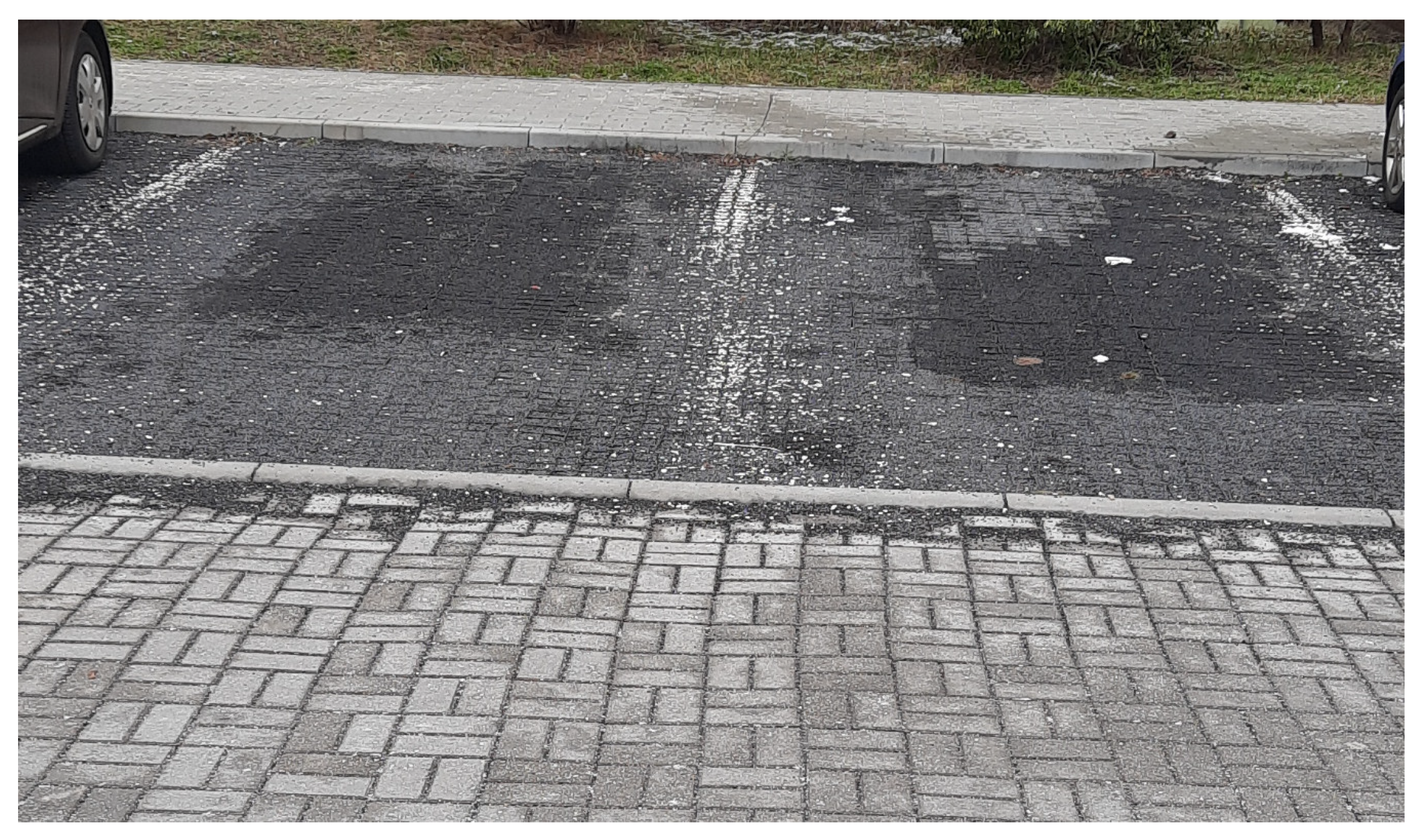
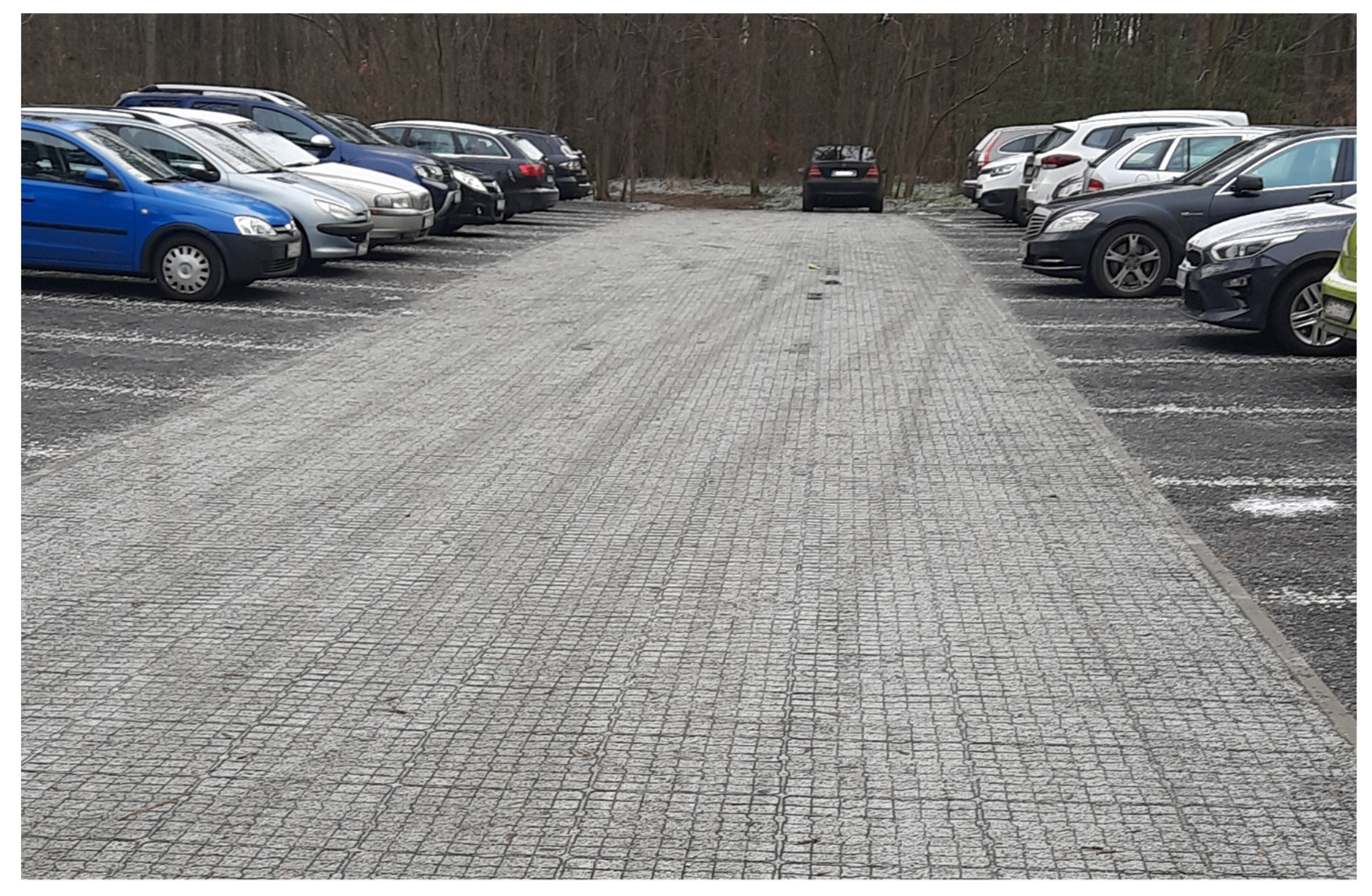
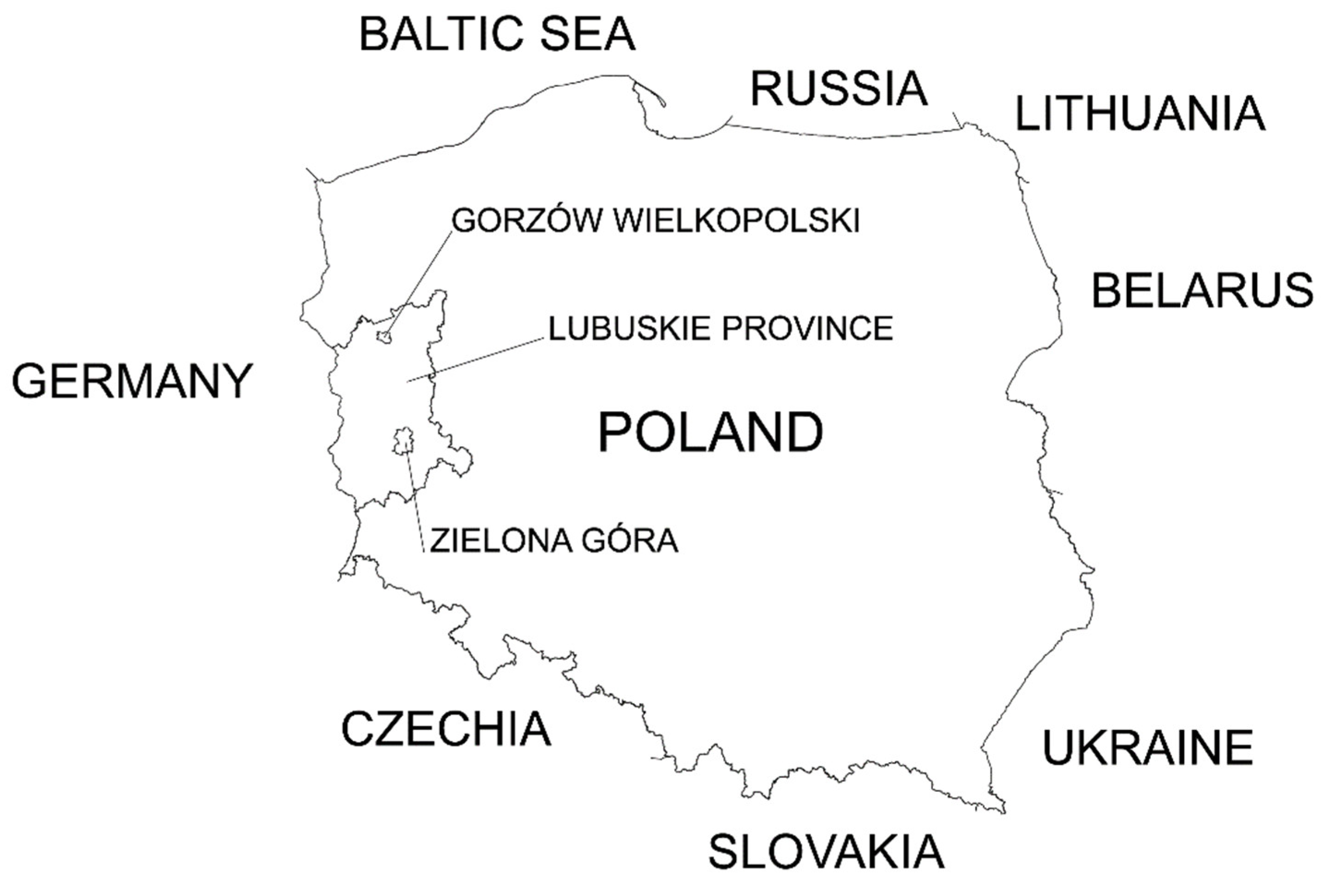
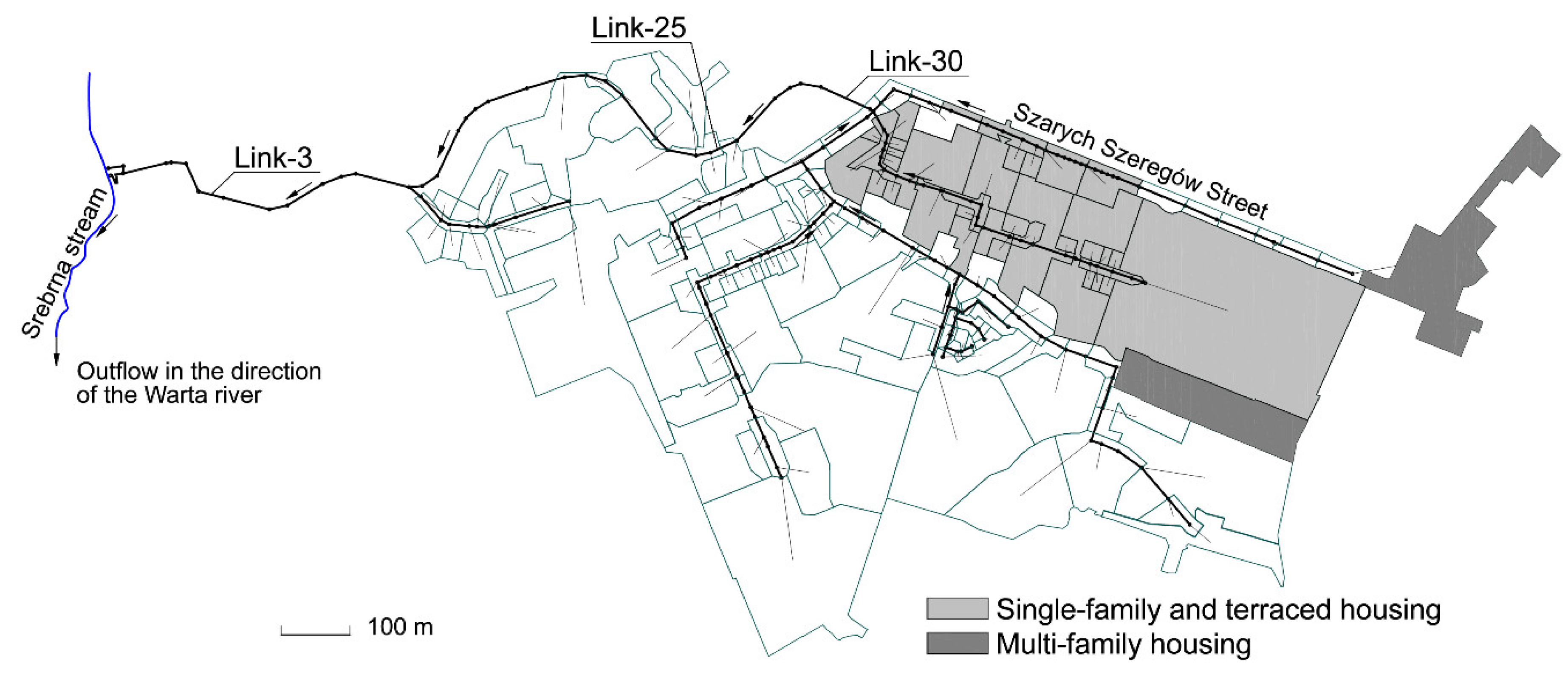
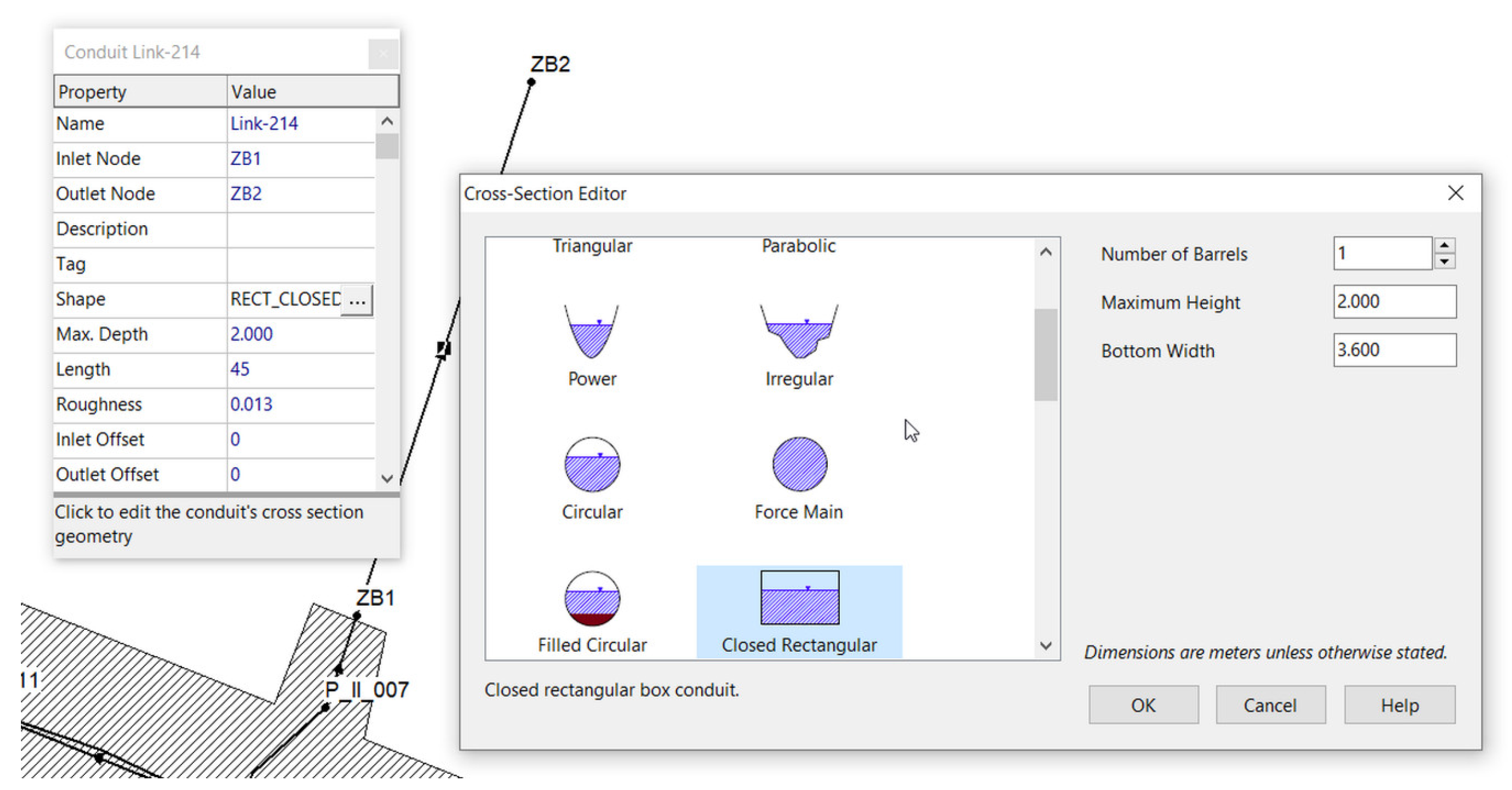
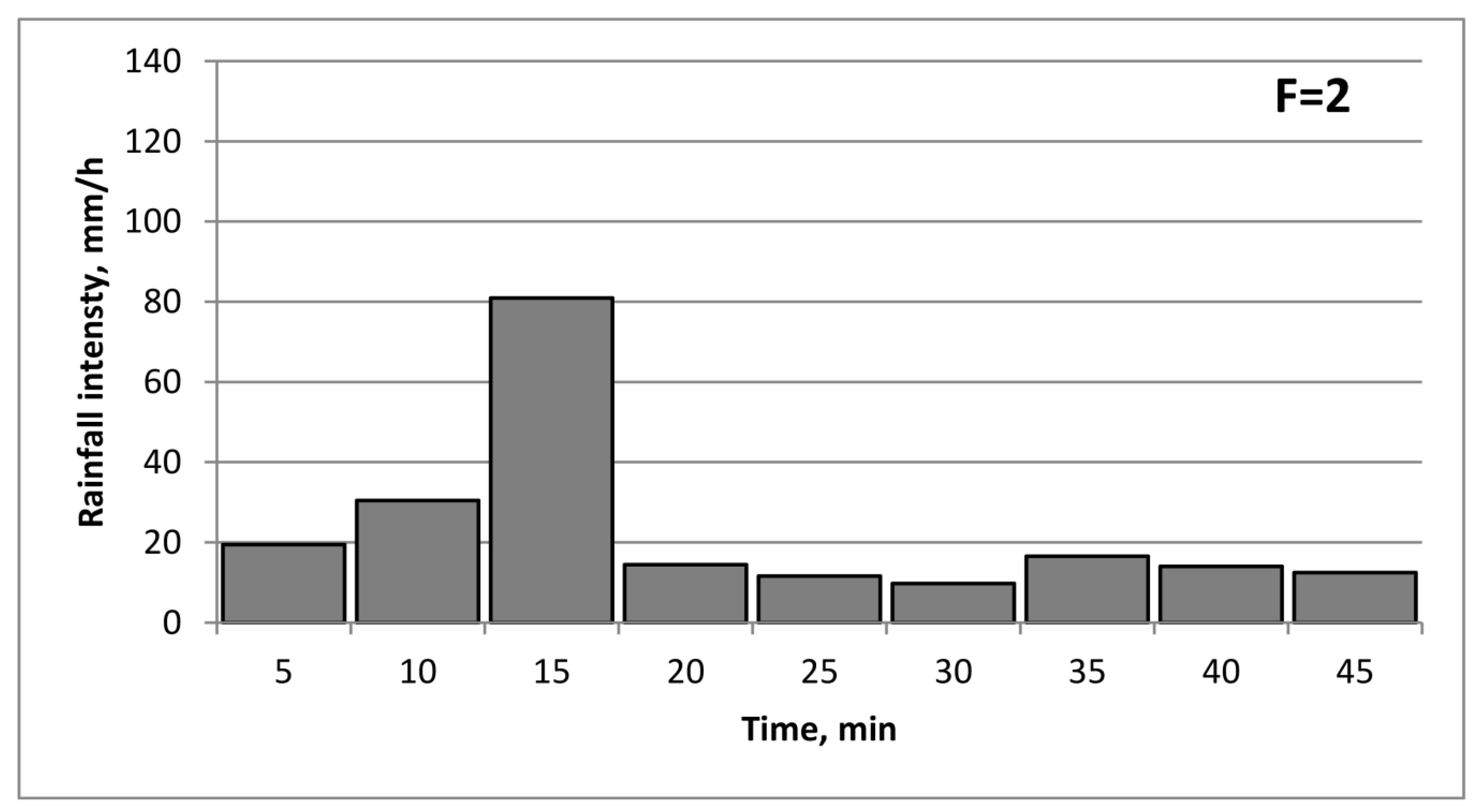
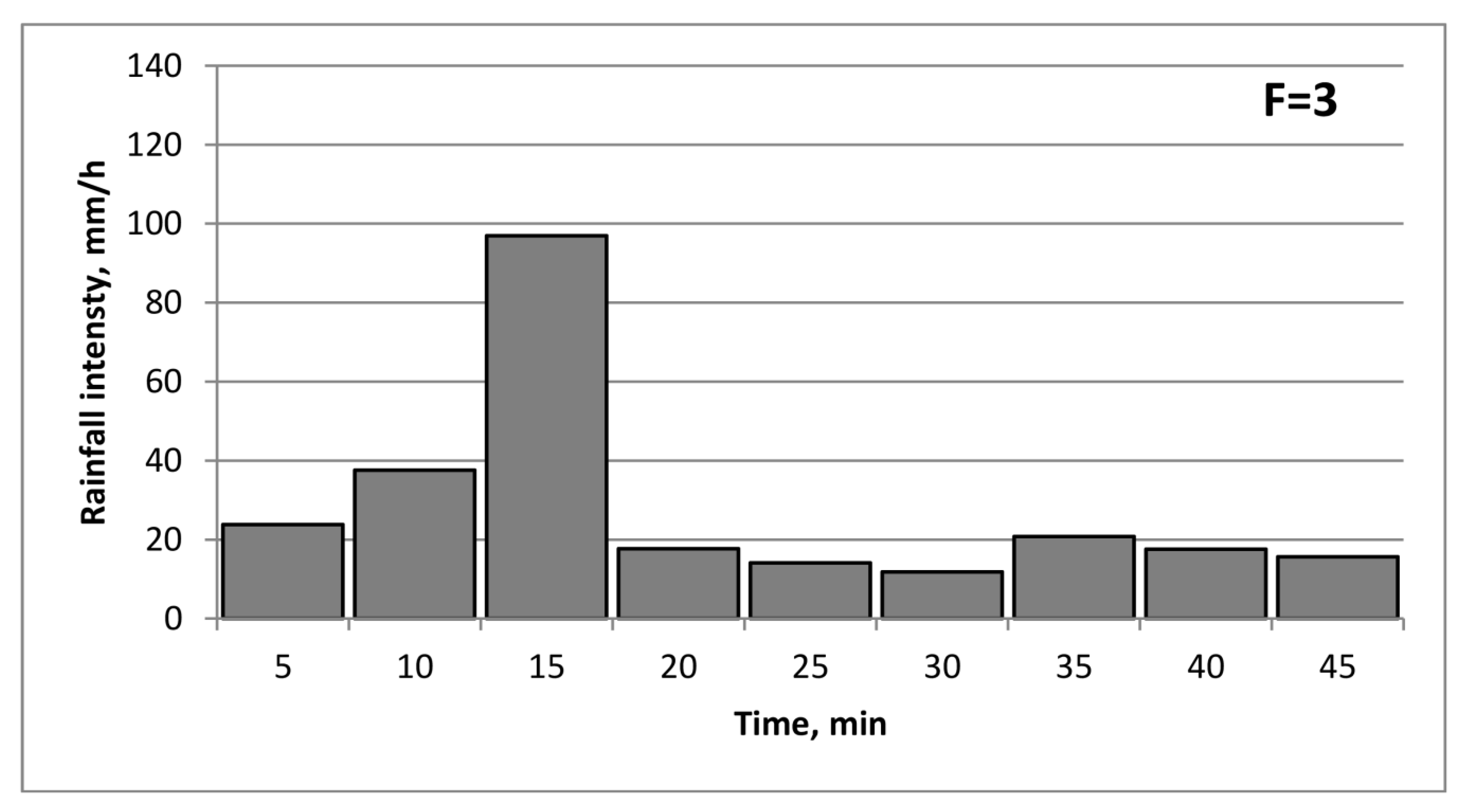
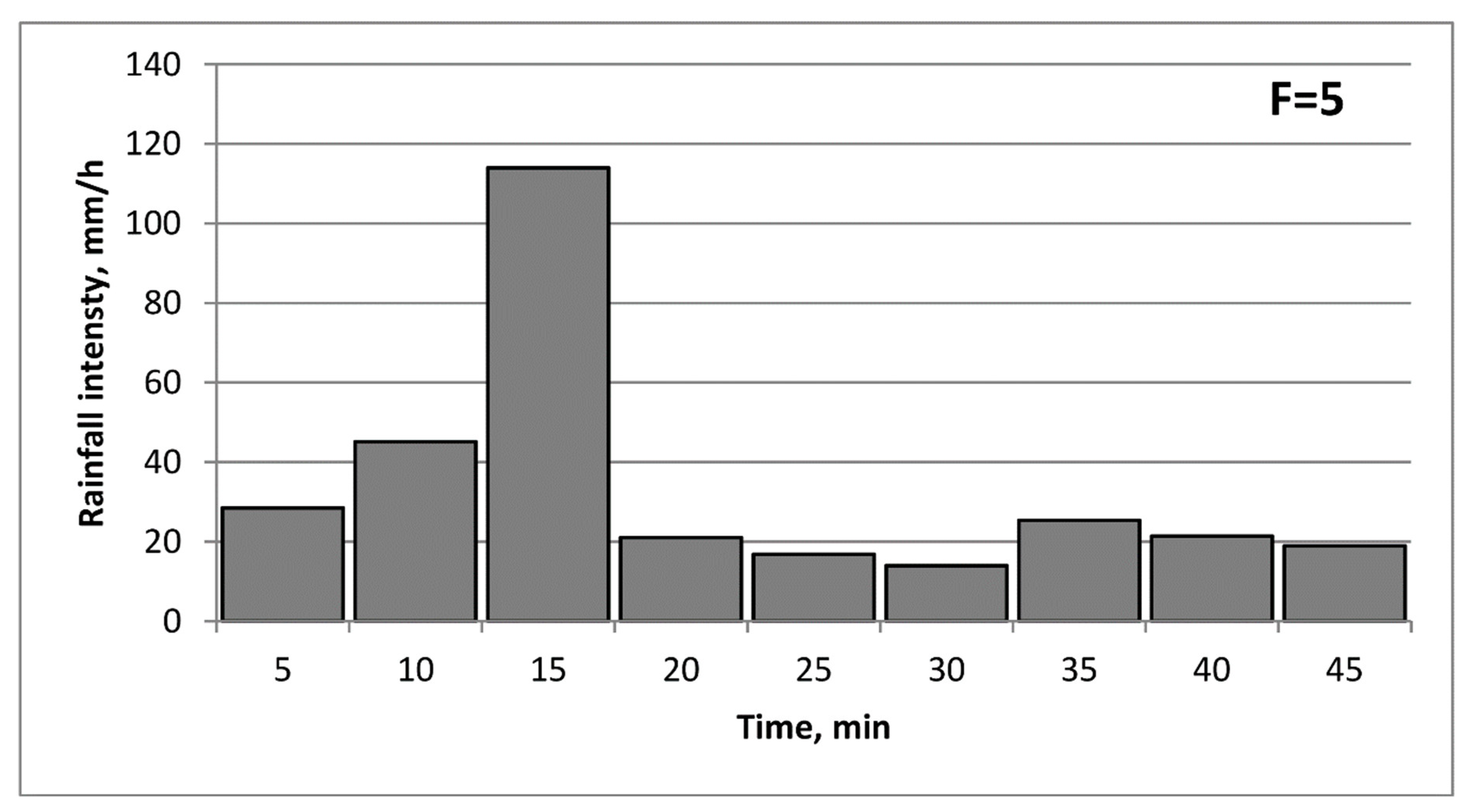
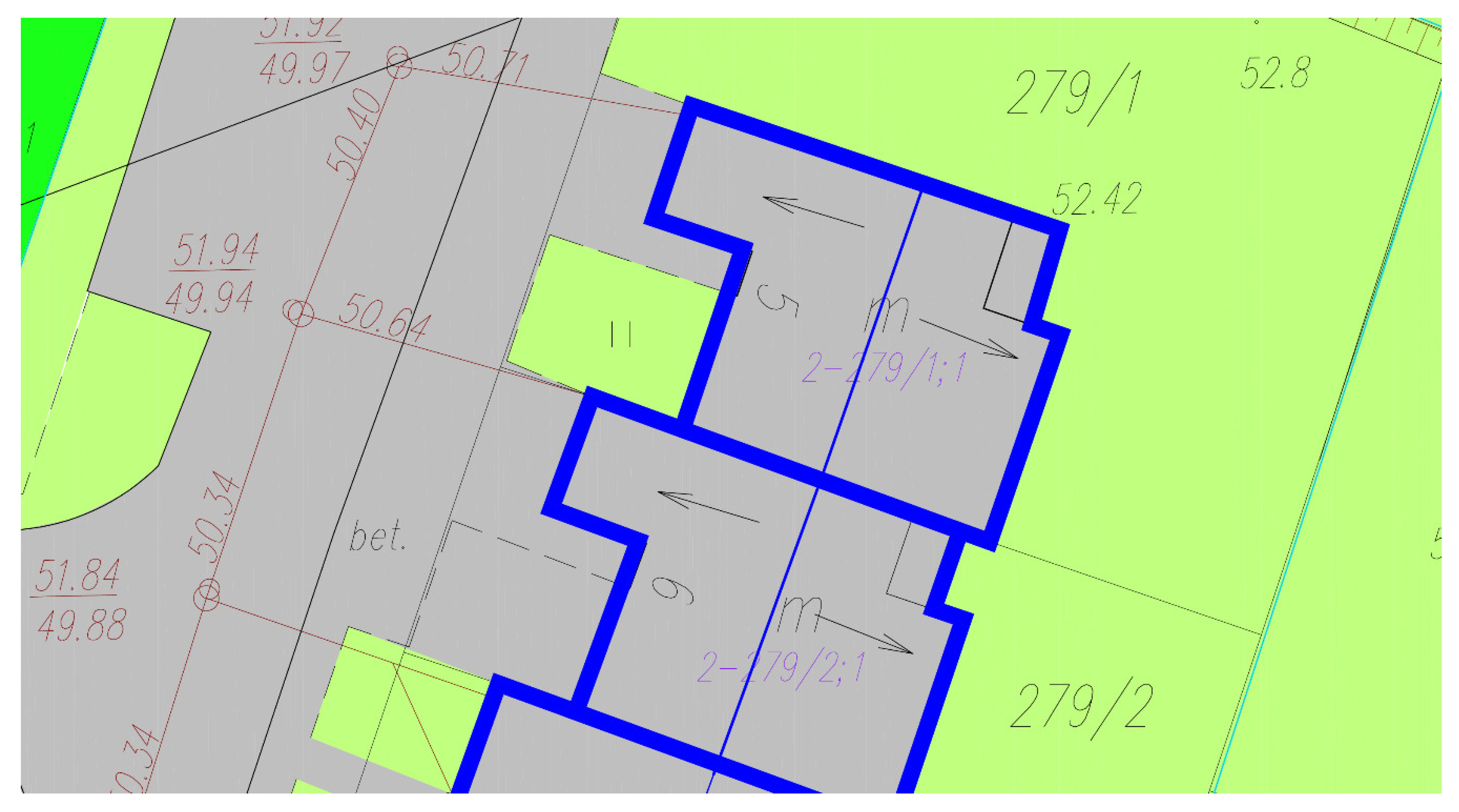
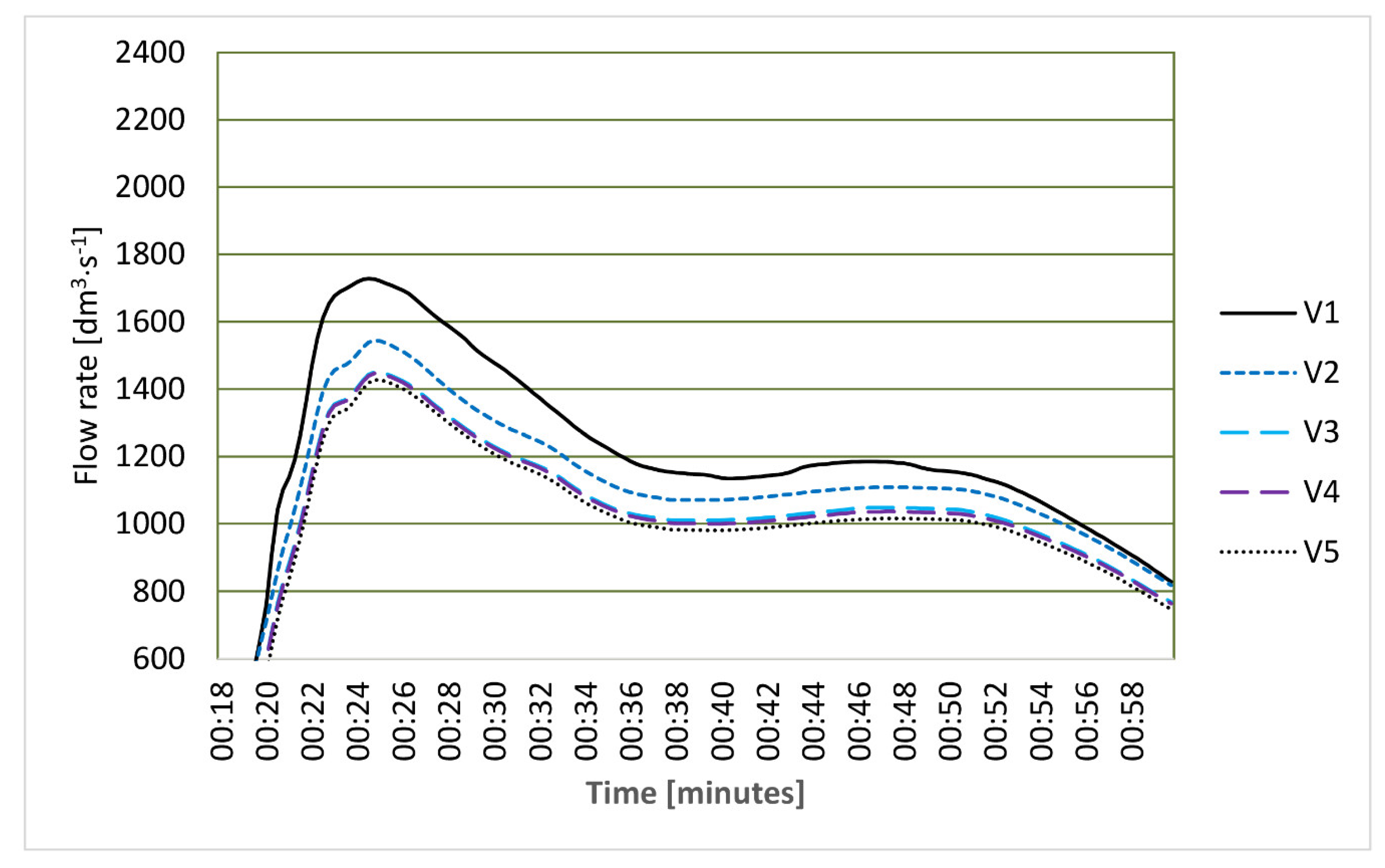
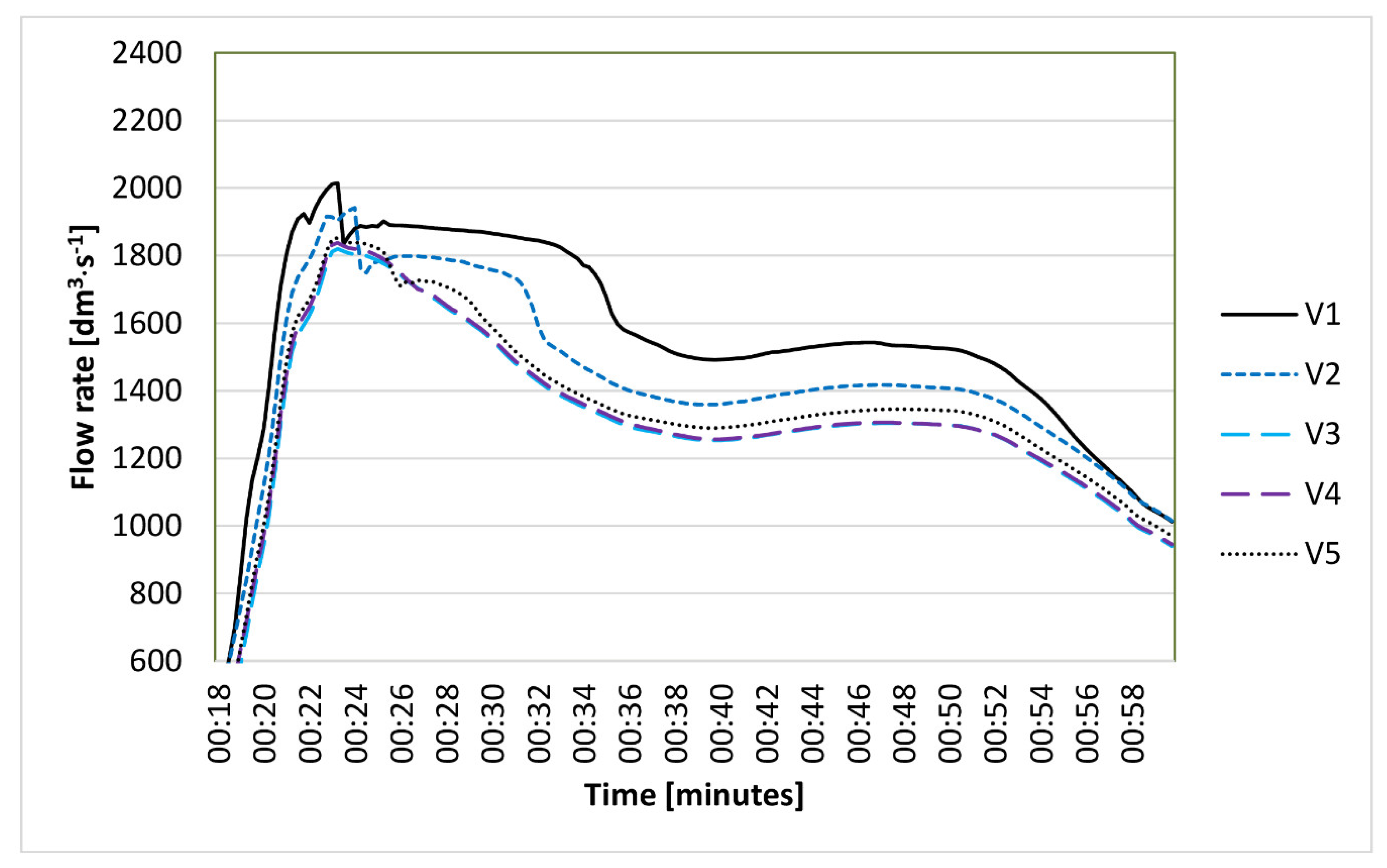
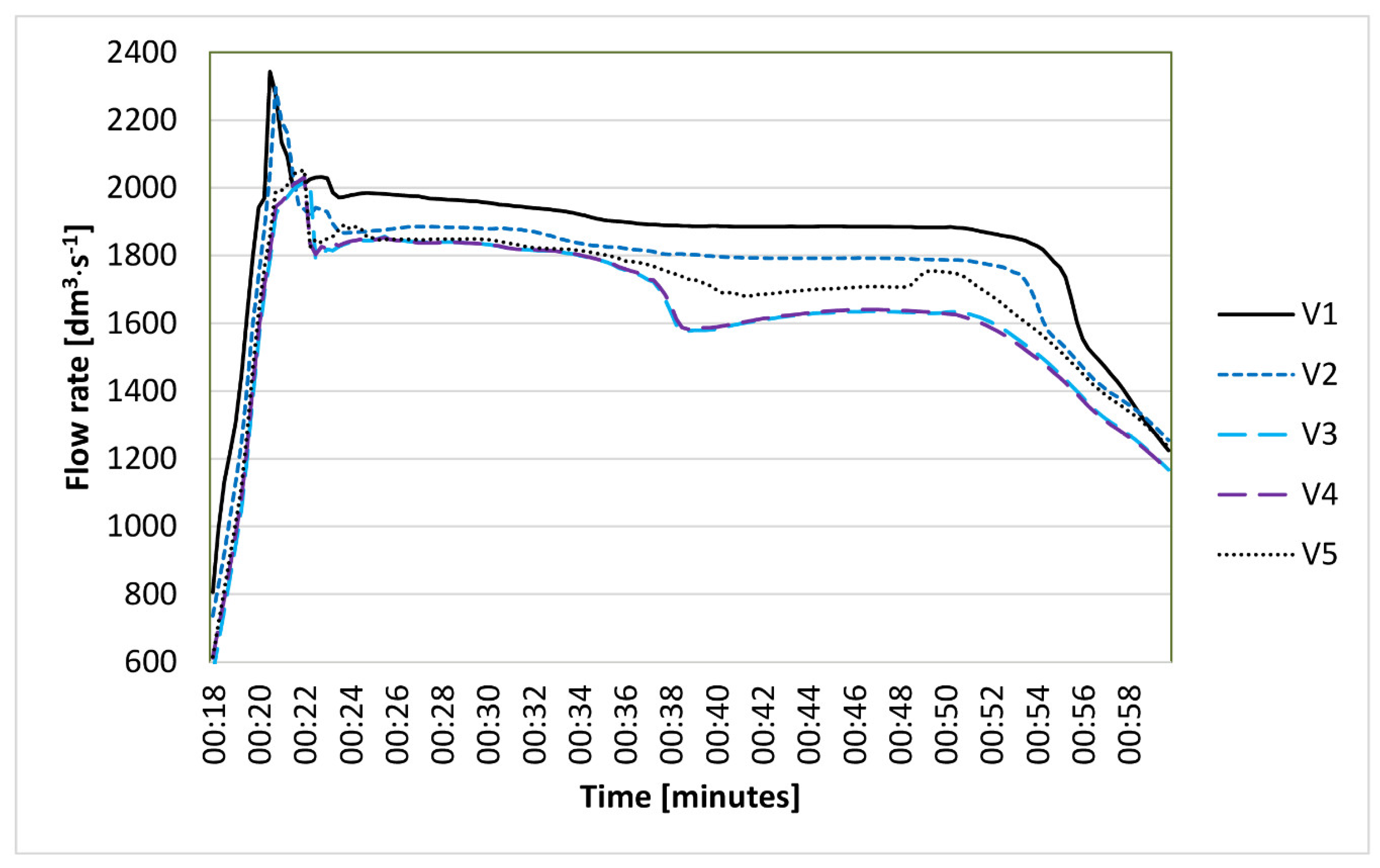
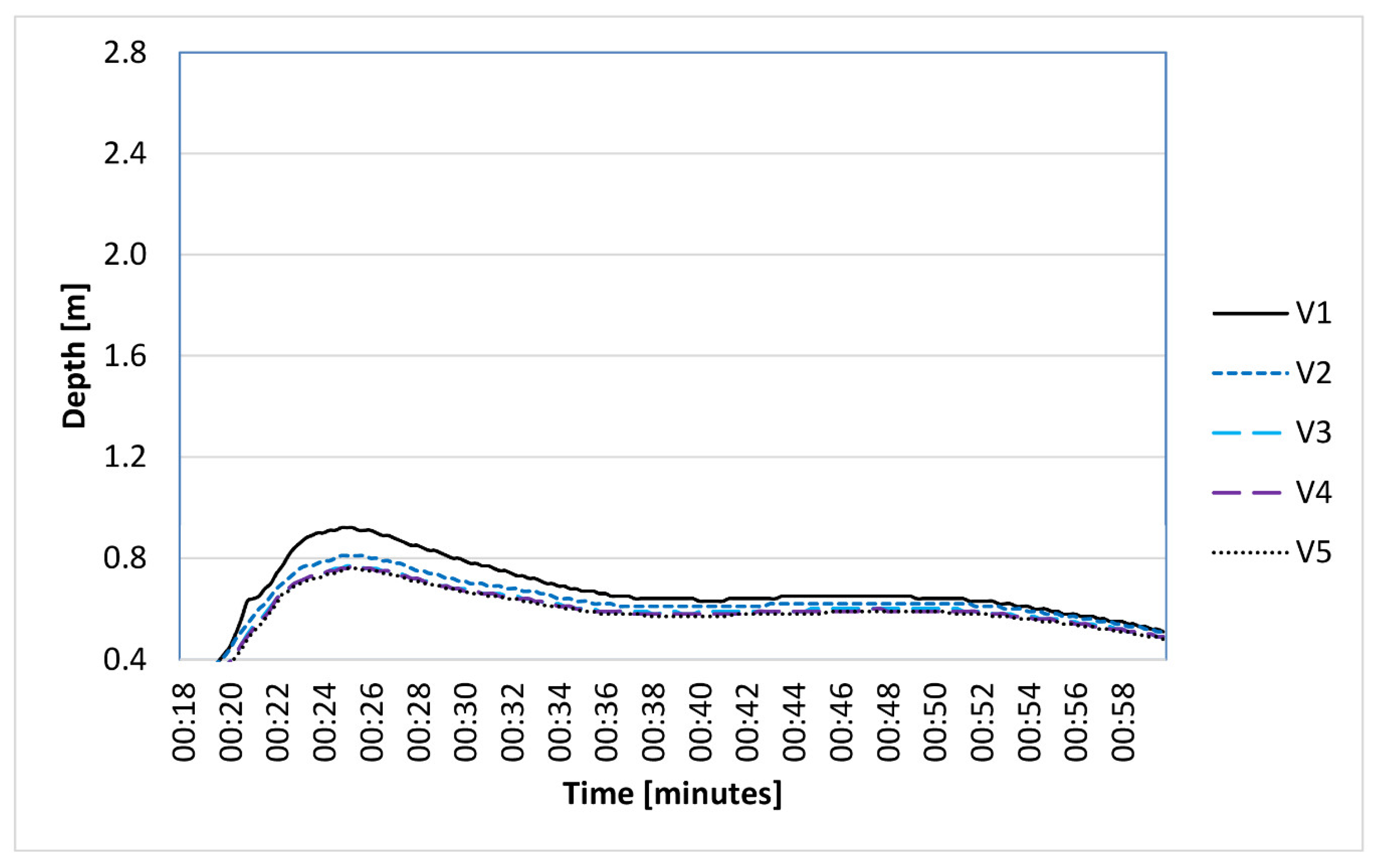

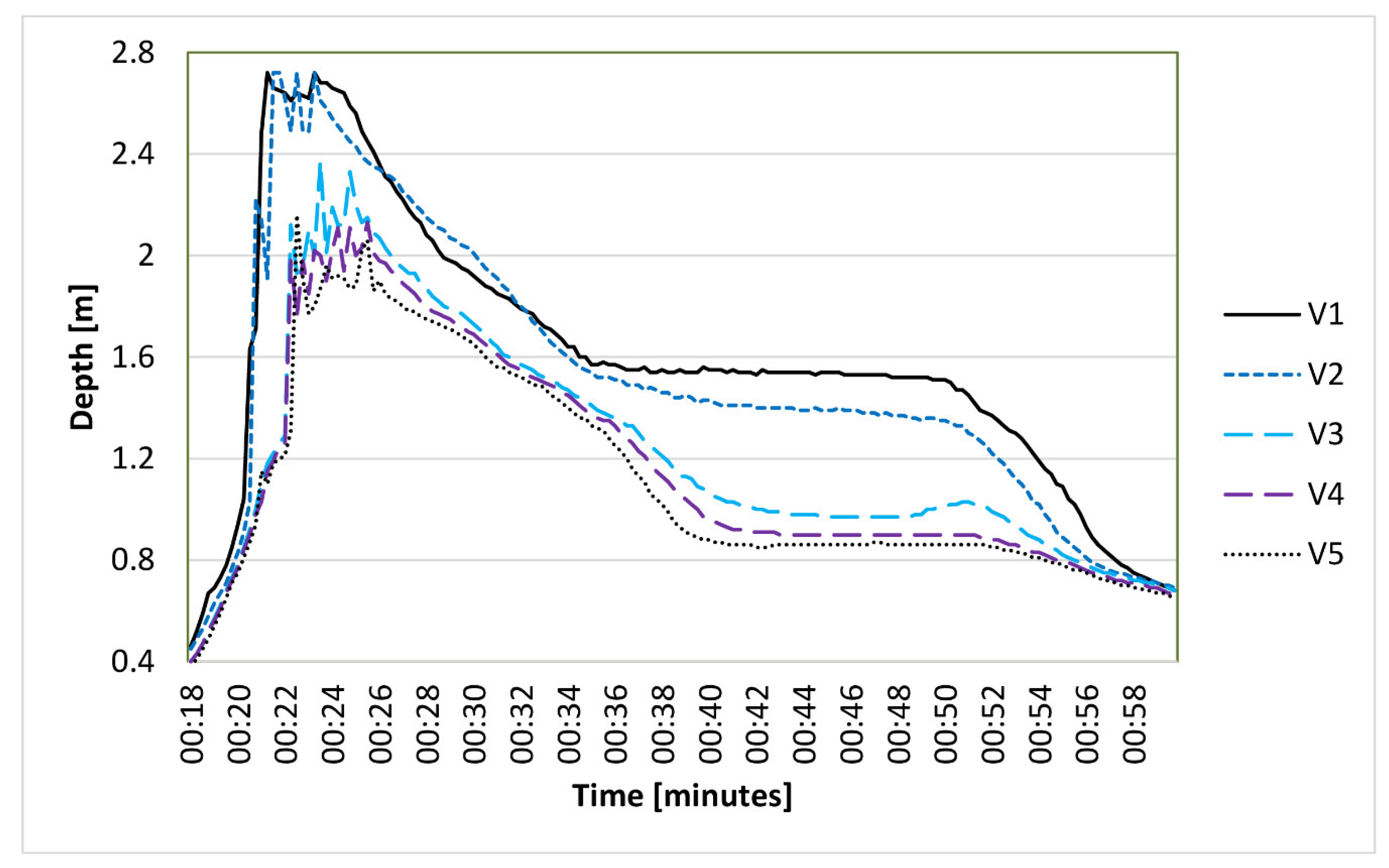
| Habit | Common Name | Scientific Name |
|---|---|---|
| Bulbous perennials | Garlic and onions | Allium spp. |
| Fern | Royal fern | Osmunda regalis |
| Male fern | Dryopteris felix-mas | |
| Broad buckler fern | Dryopteris dilatata | |
| Grass | Switch grass | Panicum virgatum |
| Zebra grass | Miscanthis sinensis | |
| Herbaceous perennial | Culvers root | Veronicastrum virginicum |
| Aster | Aster spp. | |
| Stinking hellebore | Helleborus foetidus | |
| Columbine | Aquilegia spp. | |
| Inula | Inula hookeri | |
| Hemp agrimony | Eupatorium cannabinum | |
| Bellflower | Campanula glomerata | |
| Sneezeweed | Helenium sp. | |
| Plantain lilies | Hosta spp. | |
| Shrub | Guelder rose | Viburnum opulus |
| Dogwood | Cornus sanguinea | |
| Lesser periwinkle | Vinca minor | |
| Rhizomatous perennial | Bugle | Ajuga reptans |
| Elephants ear | Bergenia sp. | |
| Yellow flag | Iris pseudocorus | |
| Siberian flag | Iris sibirica | |
| Pendulous sedge | Carex pendula |
| Link-3 | Frequency of Model Rainfall | |||||
|---|---|---|---|---|---|---|
| 2 Years | 3 Years | 5 Years | ||||
| Q dm3·s−1 | H m | Q dm3·s−1 | H m | Q dm3·s−1 | H m | |
| Variant V1 | 2016.25 | 0.65 | 2331.69 | 0.72 | 2709.16 | 0.82 |
| Variant V2, % | 3.3 | 1.5 | −0.9 | −1.4 | −1.2 | −1.2 |
| Variant V3, % | 7.6 | 3.1 | 2.8 | 1.4 | 3.6 | 2.4 |
| Variant V4, % | 7.8 | 4.6 | 2.8 | 1.4 | 3.9 | 3.7 |
| Variant V5, % | 8.7 | 4.6 | 3.3 | 1.4 | 4.5 | 3.7 |
| Link-25 | Frequency of Model Rainfall | |||||
|---|---|---|---|---|---|---|
| 2 Years | 3 Years | 5 Years | ||||
| Q dm3·s−1 | H m | Q dm3·s−1 | H m | Q dm3·s−1 | H m | |
| Variant V1 | 1721.34 | 0.92 | 1912.87 | 1.88 | 2195.13 | 2.38 |
| Variant V2, % | 10.4 | 9.8 | 4.1 | 19.1 | 1.3 | −33.6 |
| Variant V3, % | 15.6 | 15.2 | 6.6 | 30.3 | 12.5 | −3.4 |
| Variant V4, % | 15.6 | 15.2 | 7.5 | 32.4 | 14.0 | 9.2 |
| Variant V5, % | 16.7 | 16.3 | 8.3 | 33.0 | 14.5 | 6.3 |
| Link-30 | Frequency of Model Rainfall | |||||
|---|---|---|---|---|---|---|
| 2 Years | 3 Years | 5 Years | ||||
| Q dm3·s−1 | H m | Q dm3·s−1 | H m | Q dm3·s−1 | H m | |
| Variant V1 | 1728.23 | 0.92 | 2013.94 | 1.72 | 2342.54 | 2.72 |
| Variant V2, % | 10.6 | 12.0 | 3.6 | 14.0 | 0.8 | 0.0 |
| Variant V3, % | 16.0 | 16.3 | 8.0 | 33.7 | 13.5 | 12.9 |
| Variant V4, % | 16.3 | 16.3 | 8.3 | 36.6 | 14.0 | 21.7 |
| Variant V5, % | 17.4 | 17.4 | 9.6 | 42.4 | 15.2 | 20.6 |
| Link-3 | Frequency of Model Rainfall | ||
|---|---|---|---|
| 2 Years | 3 Years | 5 Years | |
| Variant V1, m3 | 5710 | 7290 | 8810 |
| Variant V2, % | −2.8 | −4.0 | −6.5 |
| Variant V3, % | 3.3 | 0.8 | −2.8 |
| Variant V4, % | 3.9 | 1.9 | −1.4 |
| Variant V5, % | 6.0 | 4.0 | 0.7 |
| Link-25 | Frequency of Model Rainfall | ||
|---|---|---|---|
| 2 Years | 3 Years | 5 Years | |
| Variant V1, m3 | 4700 | 5950 | 7100 |
| Variant V2, % | 0.9 | 0.3 | −2.0 |
| Variant V3, % | 8.1 | 6.2 | 2.4 |
| Variant V4, % | 8.7 | 7.6 | 4.2 |
| Variant V5, % | 11.1 | 10.1 | 6.8 |
| Link-30 | Frequency of Model Rainfall | ||
|---|---|---|---|
| 2 Years | 3 Years | 5 Years | |
| Variant V1, m3 | 4660 | 5900 | 7040 |
| Variant V2, % | 0.9 | 0.5 | −1.8 |
| Variant V3, % | 8.2 | 6.3 | 2.6 |
| Variant V4, % | 8.8 | 7.6 | 4.4 |
| Variant V5, % | 11.6 | 10.3 | 7.0 |
| Frequency of Model Rainfall | |||
|---|---|---|---|
| 2 Years | 3 Years | 5 Years | |
| Variant V1, m3 | 78 | 246 | 721 |
| Variant V2, % | 70.5 | 63.8 | 56.6 |
| Variant V3, % | 70.5 | 63.8 | 61.0 |
| Variant V4, % | 70.5 | 63.8 | 61.4 |
| Variant V5, % | 70.5 | 64.2 | 62.0 |
| Frequency of Model Rainfall | |||
|---|---|---|---|
| 2 Years | 3 Years | 5 Years | |
| Variant V1, m3 | 5706 | 7407 | 9393 |
| Variant V2, % | −1.9 | −2.5 | −2.2 |
| Variant V3, % | 4.0 | 2.1 | 1.4 |
| Variant V4, % | 4.6 | 3.2 | 2.8 |
| Variant V5, % | 6.7 | 5.3 | 4.7 |
Publisher’s Note: MDPI stays neutral with regard to jurisdictional claims in published maps and institutional affiliations. |
© 2021 by the author. Licensee MDPI, Basel, Switzerland. This article is an open access article distributed under the terms and conditions of the Creative Commons Attribution (CC BY) license (http://creativecommons.org/licenses/by/4.0/).
Share and Cite
Nowogoński, I. Runoff Volume Reduction Using Green Infrastructure. Land 2021, 10, 297. https://doi.org/10.3390/land10030297
Nowogoński I. Runoff Volume Reduction Using Green Infrastructure. Land. 2021; 10(3):297. https://doi.org/10.3390/land10030297
Chicago/Turabian StyleNowogoński, Ireneusz. 2021. "Runoff Volume Reduction Using Green Infrastructure" Land 10, no. 3: 297. https://doi.org/10.3390/land10030297






